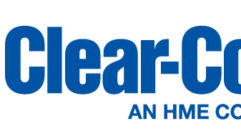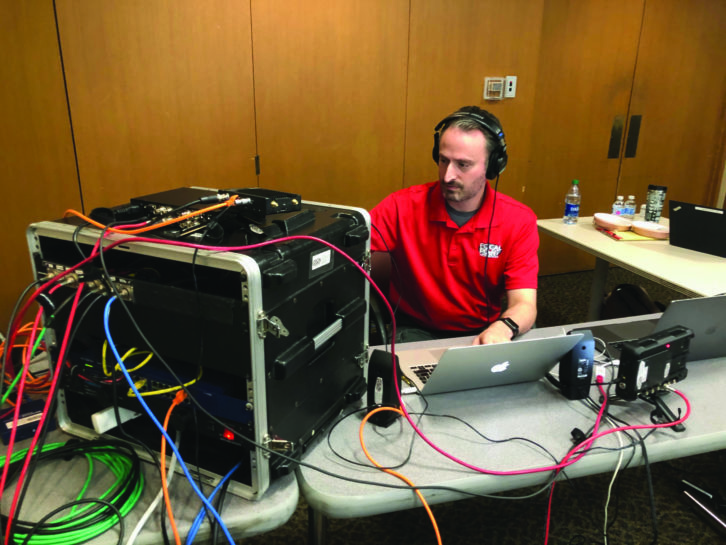
The Covid-19 pandemic has hit the medical community hard and real time information exchange is vital. Focal Point Productions put their expertise in videoconferencing and livestreaming to work for Greater Baltimore Medical Center with hospital town hall meetings and live Facebook streaming with real time Q&A. Focal Company president Marty Jenoff has the story on how it came together.
SVC: Before we get into your projects for Greater Baltimore Medical Center, tell us about Focal Point Productions.
Marty Jenoff: I got my start in video production at the age of 13 when I started doing it for fun at some friends’ parties and weddings. My passion for video continued through high school and college, and when I graduated from college in 2000 I started Focal Point Productions with three other friends. Over the first couple of months they kind of got out of the business and pretty quickly it was just me. In the beginning, it was mostly weddings, social events, not too many corporate events. And then in 2008 when the economy tanked, the first thing to get cut from every wedding or party was video. But lucky for me that’s around the time when Facebook and YouTube started to come out and when customers wanted video for their websites. So I started doing corporate work in 2008 and in 2011 I started dabbling in livestreaming and webcasting. Now all I do is corporate events and livestreaming is a huge chunk of my business.
And how would you have known way back then that we would be in the situation we have now and suddenly people have few other ways to connect? What has Focal Point’s response to the coronavirus outbreak been?
Just before the coronavirus hit work was really busy for us. We had a lot of livestreaming jobs and corporate jobs for the rest of March, April was booked, May was really busy. We were going to have a great couple of months. But once the coronavirus hit, everything got canceled. All of our jobs got immediately cancelled, but I got an enormous amount of enquiries about livestreaming. I got more phone calls and more emails about livestreaming in four days than in the last six months.
Yes, that’s incredible.
Yeah. I mean, like you said livestreaming is now the only way for people to be in contact whether it’s using Zoom or Skype or WebEx or Facebook Live. That’s really the only way for meetings, for businesses to talk to their customers or their clients in a quick, time-efficient manner. So we’ve done several livestreams for one of our clients, which is Greater Baltimore Medical Center, GBMC, which is in Baltimore County. They’ve been one of our clients for a long time and we’ve done livestreams for them before. They reached out to us pretty quickly about helping them to communicate with the community and to communicate with their employees as well.
Certainly, there can’t be a higher calling than that right now because they’re the people on the front lines. What have you been doing to help their people communicate?
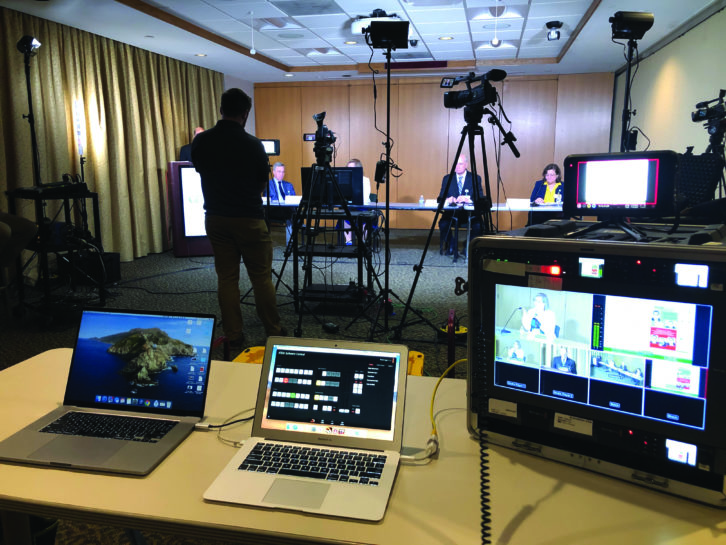 One of the first livestreams that they wanted our help with was to do a leadership town hall with the president of the hospital, the Chief Medical Officer, head of Human Resources, and their Infectious Control Disease Manager. To allow those people to talk directly to the nurses, the doctors, all of the staff of the hospital. They wanted to do a Q&A to kind of tell them where are we now? This is what’s happening. This is where we think it’s going to go. And then answering all of their questions. We did this first one right as things started and this hospital system has 4,000 employees. With very little notice our livestream had more than 600 viewers. So about 15-20 percent of their workforce tuned in to watch. We did our third one and had over 1,000 people watch. More than a quarter of the employee workforce tuned in to watch live to hear what was happening.
One of the first livestreams that they wanted our help with was to do a leadership town hall with the president of the hospital, the Chief Medical Officer, head of Human Resources, and their Infectious Control Disease Manager. To allow those people to talk directly to the nurses, the doctors, all of the staff of the hospital. They wanted to do a Q&A to kind of tell them where are we now? This is what’s happening. This is where we think it’s going to go. And then answering all of their questions. We did this first one right as things started and this hospital system has 4,000 employees. With very little notice our livestream had more than 600 viewers. So about 15-20 percent of their workforce tuned in to watch. We did our third one and had over 1,000 people watch. More than a quarter of the employee workforce tuned in to watch live to hear what was happening.
Since it’s live, you can get them up-to-the-minute information and listen to their reactions and get the give and take between those providing the information and the medical workers making use of it. No substitute for live interaction at a time like this.
Yeah. Our client decided to use Cisco’s Webex for this. They have a great chat feature. We probably received dozens and dozens of questions and comments from employees watching and the moderator was able to follow along and was able to direct those questions to the proper person immediately. We were able to answer so many people’s questions right then on the spot only because we were doing it live.
Well, you’ve been in this at the professional level for a while. What do you think when you see so many people trying to get into videoconferencing almost overnight?
Like you said I’ve seen tons of examples of people trying to do their own livestreams, whether it’s you seeing it on the nightly news interviewing experts or even hosts or reporters in their homes using their own setups, or more professional setups like we did for GBMC. But more often than not a lot of what I’m seeing is people doing it wrong. And a lot of the things you can do to make livestreaming look good, they can be pretty easy and they can be pretty inexpensive, but I’m not seeing people do it mostly because they just don’t know any better.
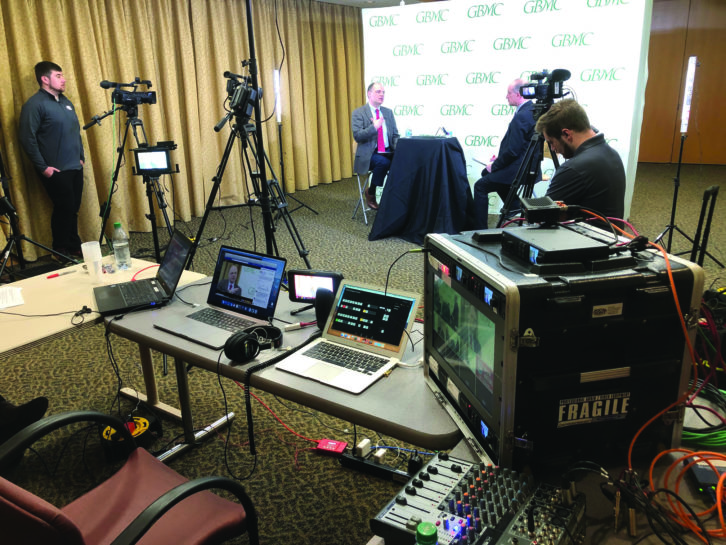 For audio, usually, there’s no way for them to hear how they really sound and a lot of things they do that are really distracting, they don’t even notice. At least not unless they eventually get to see the recorded video.
For audio, usually, there’s no way for them to hear how they really sound and a lot of things they do that are really distracting, they don’t even notice. At least not unless they eventually get to see the recorded video.
Yeah. Audio is a really big thing where people are using the built-in microphone on their laptop computer, which is probably 12 to 18 inches away from their mouth so it sounds really bad. They’re using their laptop’s builtin camera, which is a tiny, tiny little thing which doesn’t do really well and so the image is bad. And then when you add the fact in that the camera is below their nose, so the camera is looking up and all you can see is people’s nose hairs and you can see their chins and you can see the ceiling of wherever they are. The lighting is bad. I’ve seen so many bad examples, but it only takes a couple of simple tips to improve that quality.
So what did you learn on the initial town hall event that was particularly useful in doing the rest of them?
We did the first one at the hospital’s conference center and they have a computer set up in their podium, which they use for doing all of their PowerPoint presentations in the conference center. And also they use the same computer for doing their own Webex broadcasts. They have your typical small pan-tilt-zoom camera mounted into the ceiling and these microphones that drop down from the ceiling that they use when doing their own livestreaming. So we were able to use the Blackmagic web presenter to get our video and our audio into their computer to do the Webex and we changed over the correct inputs for the audio and the video. But one thing the staff forgot to do was to adjust the audio levels. So they had the audio levels in Webex set to their internal system and didn’t adjust it to our audio levels. So for the first 15 minutes our audio was distorted until people watching online were able to let us know through the chat that there was audio issues. We were able to troubleshoot it to figure out what the problem was to then make that adjustment. So now we know to really double and triple check our settings in Webex. Everything was great on our end, it was the Webex computer that had some switches that had to be configured to work well with what we were providing it. And then something else that is happening with Webex, and this is probably happening with virtual meetings all over the place is participants and viewers forget to mute their microphones and turn off their video cameras. So we had a lot of people with open microphones talking and we will go in and we would mute them and then for some reason they would just go back and unmute themselves. So that just creates a lot of background noise for all the other participants.
Yes, I was watching just the other night and how often do you get to see a network newscast interrupted by a dog barking in the background?
Oh, wow, yeah. I was a viewer on a livestream today and there were constantly open microphones. And you would hear, like you said, a dog barking, a parrot screaming in the background, kids yelling while the presenter is trying to talk and it just is so distracting to them and everyone else watching. So that happens everywhere.
What’s been the response from the hospital leaders to the town hall meetings?
The leadership has really loved what we’re doing. They love the ability to talk in real time to the constituents, to their employees. We’ve done three of these so far. We’ve done one a week for the last three weeks. After we did our last one they came to us and they said they want to continue to do one of these every week for the entire month of April. So by the end of April we will have done six or seven weekly town hall livestreams for GBMC. They’re finding that their employees want to know what’s happening and the leadership finds this is the best and easiest way to get their messaging across as quickly as possible. They’ve also asked us to kind of up our game and up the production quality of it, so we’re going to be working with them to improve lighting, improve the camera angles, improve the ambiance to give it a better look.
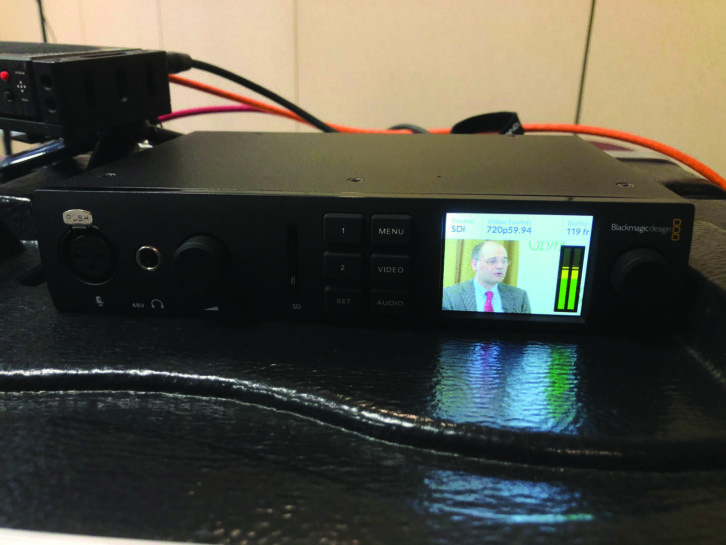 So in some cases, non-tech people. How do you get your clients ready to participate in one of these internal GBMC town hall meetings?
So in some cases, non-tech people. How do you get your clients ready to participate in one of these internal GBMC town hall meetings?
Yeah. So when a client comes to us about doing any live stream, and in specific these town halls, we really want to go over with them and find out who is involved, who’s going to be there, how many people are talking? We find out that there’s going to be a moderator and four panelists so we needed to think about camera angles, audio, microphones, audio mixer, lighting. And then we wanted to find out what distributing platform will we use. In this case, as I mentioned, they wanted to use Cisco’s Webex. And then we also want to find out how are they going to work with the questions that come in? We had over a thousand people watching our last livestream, and as you can imagine we had a lot of questions and comments coming in. So really talking with the client to figure out how would that work? What is the flow going to be for questions coming in? And then how is the moderator going to go through them and then to decide which panelist to ask each question to.
Of course, at this critical time, they want to be able to concentrate on the subject matter without the tech side getting in the way. How do they communicate on these events? Are there other ways that you can get questions from viewers?
For the livestreams, we receive questions in two different ways. The first was employees were able to submit their questions ahead of time via email or a web form that they would take to then give to the moderator. And then we also received a lot of questions live and in real time through the chatroom. For Facebook Live, same kind of thing. People were able to email in their questions ahead of time if they weren’t going to be able to watch it live, and then we also did get questions through Facebook in the comments section. And then again, the moderator would kind of take those and give them to the host in the order that they wanted them to be presented.
Right so let’s talk about the Facebook Live component you did for them.
We did several Facebook Live broadcasts. In two days we did five Facebook Lives for the hospital and for the community on different topics around Covid-19. We did one about anxiety and depression. We did one on heart health. We did one on diabetes. We did one on just answering common questions related to the disease – to the virus; how you can protect yourself and things like that. And then we did one on the hospital’s obesity weight loss program. We did four of them at the hospital in their conference center and then we did one of them in our studio, which is about 20 or 30 minutes away from the hospital. So—to clarify–we did the town halls, which were just for internal employees and then we did the Facebook Lives, which were for the community in the whole.
And those are two different animals.
We did use a very similar setup for both. We use multiple cameras. We use anywhere from two to four cameras. We use our Blackmagic ATEM television studio as our switcher and hub. The audio mixer and microphones – so the setup for both of them, the town hall and the Facebook Live, had a lot of similarities.
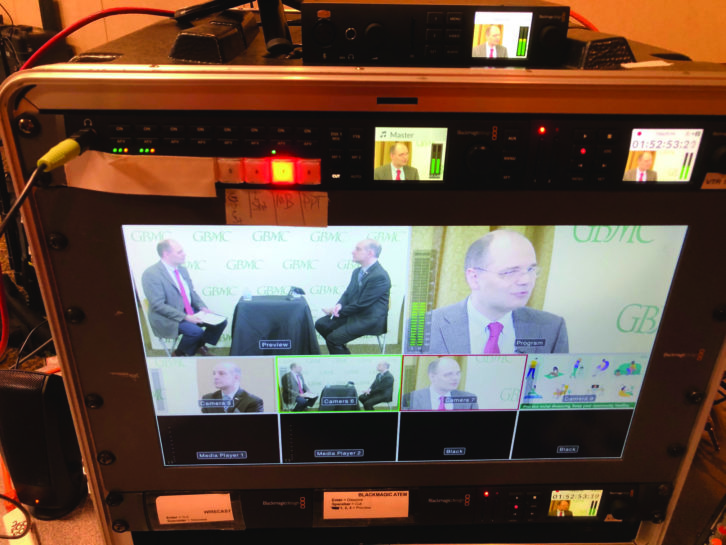 Are there specific features on the Blackmagic Design ATEM Television Studio HD that work especially well for this? What made you choose that one?
Are there specific features on the Blackmagic Design ATEM Television Studio HD that work especially well for this? What made you choose that one?
For these broadcasts, town hall and Facebook Live, we knew that we wanted to use multiple cameras. We knew that we wanted to have a wide shot, a tight shot on the moderator, a tight shot on whoever on the panel is speaking and we knew that we also wanted to use some PowerPoint slides. So one of the great things about the ATEM Television Studio HD is it has multiple inputs. It gives us four HDMI connections and four SDI connections so it was really easier for us to connect all of those cameras and computers to the ATEM to switch back and forth. We could add in lower third titles. We could add in an opening and closing title screen for the broadcasts. It has a program output, which is our main output, which we would send to our Teradek livestreaming encoder. And then it also has an auxiliary output, a secondary output, that we can use to send a signal to a confidence monitor or another screen or monitor for the presenters or moderators or panelists to be able to see while we’re livestreaming. OK with what you can carry in one hand, you have much of the capability of a whole TV control room. Yeah. I have a great rackmount case which is maybe the size of a small suitcase and in there I have the Blackmagic ATEM TV studio, I have two Blackmagic recording decks so I can record a primary and a backup, and then I also have the Blackmagic Multiview monitor. So in one case I have these four Blackmagic devices, which gives me a whole TV studio in one traveling case.
It was interesting hearing before about how you interface their conferencing system with yours because they do have some inhouse conferencing capability.
Yeah. So they do livestream some of their own events from there. It’s using a ceilingmounted static camera. They have microphones that drop down from the ceiling, so typically when they do things there the audio and video isn’t really great. That’s why they wanted to have us come in to do these town halls for them because it’s that important. So the good thing for us was we did these town halls and the Facebook Lives all in the same room. We knew the room well. We know the lighting concerns. Where are the power outlets; how many power outlets are there? Where is the Internet connection? Where do we park and unload the van from? All those things that we usually put into our site surveys, it was really easy because we’re in the same room for multiple days doing these different live broadcasts.
I noticed that you used Blackmagic Web Presenter at the output of your stream. How did you use that?
So our client wanted to use Cisco Webex for the town halls and what we use the Blackmagic Web Presenter to do is to get the HD signal out of our Blackmagic video switcher. We need to get that into the client’s computer and so that Webex will recognize it to do the livestream. Normally when we’re doing a livestream we’re going to use one of our Blackmagic capture cards to get into our laptop to do a livestream. But because we’re at the hospital we’re unable to connect our computers to their network so we have to use their computer to do the livestream. And their computers are your typical corporate laptops or desktop computers. They don’t have Thunderbolt connections. They can’t accept one of the high-quality Blackmagic UltraStudio 4K signals. So we have to use the Blackmagic Web Presenter, which takes, again, our SDI HD signal and converts it into USB and really tricks their computer into thinking that it’s a web camera. So Webex will then recognize that USB signal and that web camera and we’re able to use our video switcher as the input into Webex. That’s how we use the Blackmagic Web Presenter for the town halls and then we also used the Blackmagic Web Presenter when we did one of our Facebook Lives. We used that to get the video signal into one of our laptops, which we used to have our host via Skype.
So that just gets your signal into a friendlier format for them.
Exactly. So the Blackmagic Web Presenter is great because it works with any computer as long as it has a USB 2.0 connection. You can get professional video into any computer, Mac or PC. No drivers are needed. It’s plug-and-play and it works. So when we’re using someone else’s computer that we can’t install programs on it’s great because it just makes life so much easier.
And it’s your responsibility to make sure all their graphics look right and are in the right format for the information they want to display visually.
Exactly. I’ll work with them to make sure, you know, if they want PowerPoint slides I’ll work to get that – to get a laptop to get that into the system. Like you said, lower thirds, full screens. If we’re doing Facebook Live getting the stream key and information and scheduling and setting up the Facebook Live and doing all that so that they don’t have to worry about it.
Based on your experience in professional situations, what advice would you have for anyone trying to make virtual connections?
A couple of tips that I always give people are find a quiet room in your house. You don’t have a lot of background noise. You also don’t want to have a very busy background. You don’t want to have kids running behind you. You don’t want a bright window behind you. So pick your room wisely. If possible don’t use Wi-Fi. Try to use a plug-in hardwired Internet connection. Try to use an external microphone. Don’t use your laptop’s built-in microphone. Use earbuds or headphones so that the speakers in your computer don’t echo back and get picked back up again by your microphone. And lastly, try to lift up your computer a couple inches so that the camera in the laptop is eye level so that the camera and the viewers aren’t looking up your nose counting your nose hairs or admiring your double chin or the ceiling in your bedroom. Lift up the camera so it’s eye level so that you’re looking straight out, not down.
The current situation is unprecedented and I would think that it is going to have a profound long-term effect on the market. What’s your take on that? What so you see coming for videoconferencing and livestreaming now?
I think the market is going to explode. I think you’re already seeing that. We’re already seeing a big jump in people using Zoom, Skype, Google Meet; all those platforms. But I think in the weeks and months ahead when things get back to normal, I think people are going to find that they really liked having these virtual meetings. I think people may still be hesitant to get out in public. People will be hesitant to go to large meetings and conferences. And I think organizers and employers are going to look to live streaming to help them reach their audiences easily and effectively for a long time. I think livestreaming is going to see a huge jump in demand.
Especially as people get more comfortable with it and the apps get even more user friendly. People don’t want to be seen struggling with it, but as it becomes more trendy perhaps that will really open the gates.
I think you’d be really hard-pressed to find someone in the U.S. that hasn’t used one of those livestreaming platforms in the last month or so. Everyone has used one of those platforms for personal or work reasons lately.
Yes, that’s a big sudden breakthrough in uptake, and in people sort of breaking through their barriers with this out of necessity. That has very interesting prospects over the long term. Thank you, Marty Jenoff, president of Focal Point Productions for talking with us.
Thank you so much for having me. I hope it helps someone.



